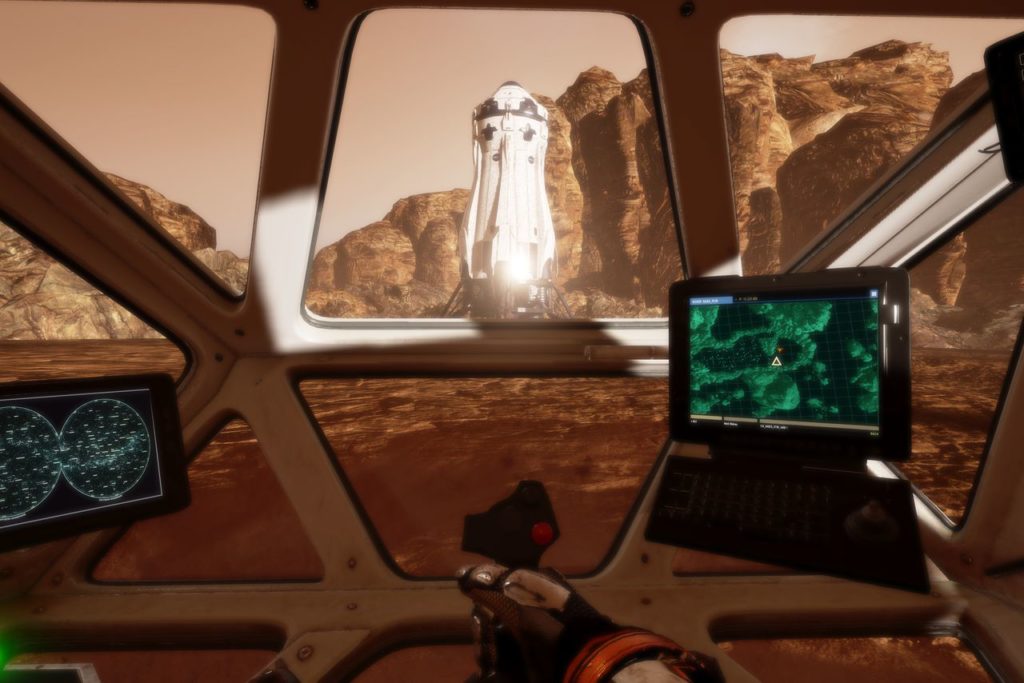After multiple delays, Fox Innovation Lab launched The Martian VR Experience for PlayStation VR and HTC Vive on November 15. The $20 experience was created by RSA Films and The Virtual Reality Company, executive produced by Ridley Scott and directed by Robert Stromberg. The interactive experience was built using Epic Games’ Unreal Engine 4 technology and marks the first public release from the Fox Innovation Lab.
Twentieth Century Fox Home Entertainment and Fox Innovation Lab president, Mike Dunn, told [a]listdaily that The Martian VR Experience blurs the line between games and movies. “Games are bringing more emotion to gameplay and we’re bringing some interactivity to our film VR experiences,” Dunn said.
Following the plot of Scott’s Oscar-nominated film, users can interact with the surface of Mars, steer at zero gravity through space, drive a rover across the red planet and play basketball with potatoes in a variety of mini-games as a virtual Mark Watney. The experience uses footage from the film starring Matt Damon to connect these interactive elements.
Dunn said the Fox Innovation Lab first explored virtual reality with a Wild 360-degree experience from Felix and Paul Studios featuring Reese Witherspoon. “We did a test shoot on Wild and proved to our studio and creative execs that VR can be a narrative emotional experience,” Dunn said. “The Martian matched the target early adopter VR audience and we felt we could take them to Mars in a new way.”
Robert Stromberg, co-founder and chief creative officer of The Virtual Reality Company, explained to [a]listdaily that multiple companies were involved in the development of this experience. “It’s still a new frontier of where everybody is jostling for all of these answers on how to make VR work,” he said. “We worked with the Q Department for sound and The Third Floor for the game controls. You have to have the right companies and specialties in a specific order, just as you would put together production on a film.”
Stromberg said additional mini-games were added to the experience after the positive reception they received. Dunn also added that the team targeted a 25-30 minute experience that is broken up into interactive segments, which can be replayed. “We weren’t sure if consumers would be comfortable in headsets more than 25-30 minutes at that time,” Dunn said.
The goal was always to create a VR experience that could be sold directly to consumers. “Some of the other studios are focused on the marketing angle of VR, but we wanted to create a commercial experience and help to shape the marketplace,” Dunn said.
The Martian VR Experience, which debuted at the 2016 Consumer Electronics Show (CES), was accepted into the prestigious New Frontier Program at Sundance and is the recipient of the Cannes Silver Lion in Digital Craft as well as the Association of Independent Commercial Producers (AICP) Next VR Award. The VR experience missed the theatrical window as well as two home entertainment windows, in part, because the hardware wasn’t ready. Now that PS VR has launched, The Martian VR Experience is available across two platforms.
The Fox Innovation Lab did release a non-interactive teaser of The Martian VR Experience on Samsung Gear VR, which became one of the most-watched VR experiences on that platform.
“For future products, we’d like to have a mobile experience that could be played untethered,” Dunn said. “We’re very bullish on the expansion of mobile VR.”
The Fox Innovation Lab was established to drive the advancement of groundbreaking technology and new consumer experiences across all platforms and distribution models. The Lab works closely with production, marketing and distribution across all Twentieth Century Fox divisions as well as key external partners to advance next generation technologies including 4K Ultra HD with high dynamic range, mobile content experiences, and virtual, augmented and mixed reality, all featuring immersive audio.
The Fox Innovation Lab also serves as a research hub, demonstrating and testing technologies with consumers throughout the development process to obtain qualitative data and hands-on feedback in order to bring innovative and premium products to market. Dunn said that all current VR, AR and mixed reality platforms, as well as some future platforms, are tested inside the lab.
“The idea behind the lab is to get out in front of media on the horizon and actually partake in those media,” Dunn said. “We started very early with VR, and we hope that we’ll be out in front of that media in terms of knowledge and production capabilities, and also introduce established and upcoming filmmakers in that media.”
Dunn believes the key filmmakers participating in VR today are going to try to push the emotional boundaries of storytelling. “At first, entering VR as more like a video game, but talking with Stromberg and Felix and Paul, they’re going to bring emotion to this medium. It’s an art form, nevertheless, and these guys have game.”
Additionally, the lab is working with filmmakers across North America, Europe and China. “There are a lot of filmmakers very interested in this medium,” Dunn said.

